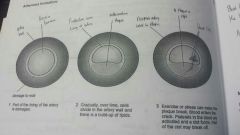![]()
![]()
![]()
Use LEFT and RIGHT arrow keys to navigate between flashcards;
Use UP and DOWN arrow keys to flip the card;
H to show hint;
A reads text to speech;
7 Cards in this Set
- Front
- Back
|
Cardiovascular Diseases |
General term used to describe diseases associated with the heart and the blood vessels Most cv diseases start with a atheroma formation |
|
|
Atheroma Formation |

●damage to the artery endothelium leads to accumulation of fatty deposits called atheroma under endothelium at the site of damage ●if the atheroma breaks through the inner lining of the artery,forms a plaque which roughens the wall of artery and reduces lumen size ●this restricts blood flow and causes blood pressure to increase ●●blood clot can form |
|
|
Coronary Heart Disease (CHD) |
Occurs when coronary arteries have lots of atheromas in them,which restricts blood flow to hear muscle |
|
|
Aneurysm |
●balloon like swelling of artery ●starts with formation of atheroma ●atheroma plaque damages/weakens arteries ●leads to narrow arteries which increase blood pressure ●blood flows at high pressure on weak artery, may push inner layers of artery through outer elastic layer to form an aneurysm ●may burst to cause haemorrhage (Bleeding) |
|
|
Thrombosis |
●formation of blood clot ●atheroma plaque can rupture the endothelium of the artery damaging the wall ●platelets accumulate at site of damage & form a blood clot ●this clot can cause complete blockage of artery lumen,or block a vessel elsewhere in the body Acclude = block |
|
|
Myocardial Infarction (Heart attack) |
●atheroma becomes unstable,piece breaks off damaging the artery wall and leading to a blood clot ●if blood clot blocks the coronary artery,heart muscle starved of blood receiving no O2 & glucose ●known as heart attack Symptoms include: -Pain in chest and upper body -shortness of breath & sweating ●●if large areas of heart are affected complete heart failure can occur & is often fatal |
|
|
Stroke |
:death of part of the brain tissue due to lack of oxygen & glucose ... due to ●blockage caused by blood clot travelling to the arteries in brain ●artery bursting F ace-distorts on 1 side (normally) A rms-weakness of limbs S peech- difficulty speaking Time to call 999 asap |

